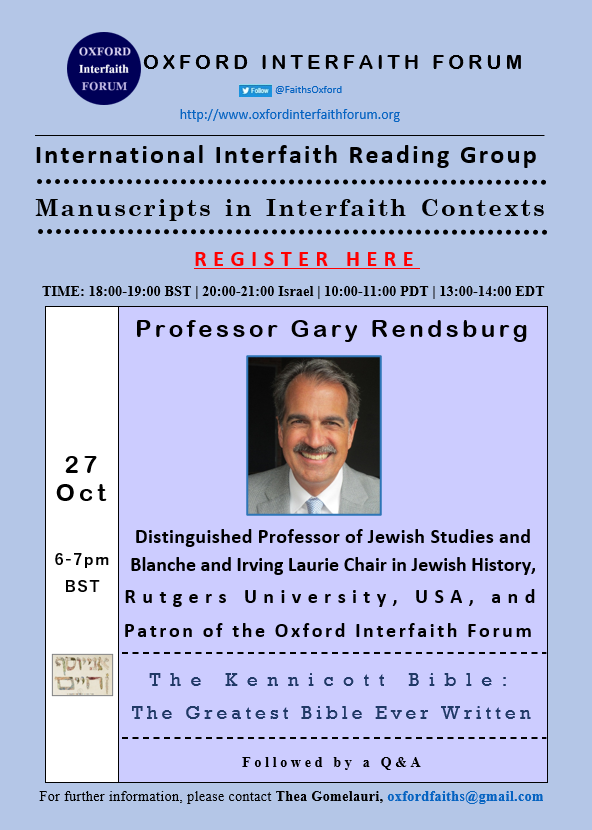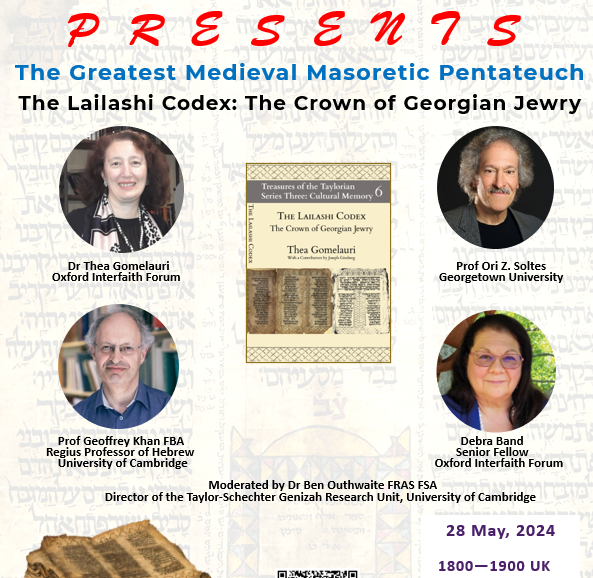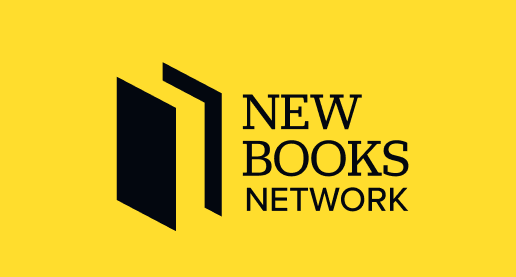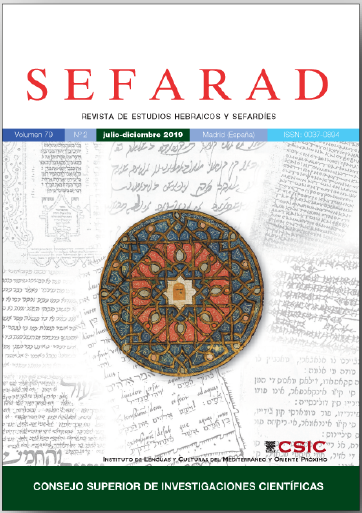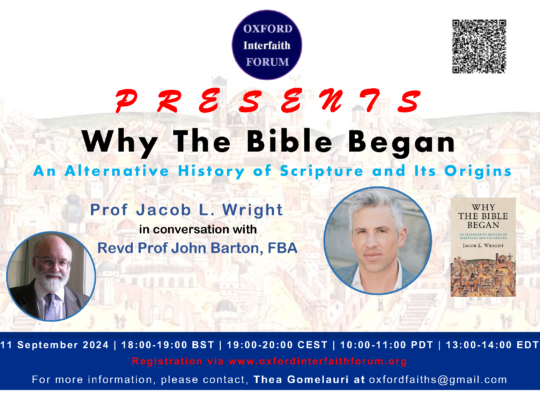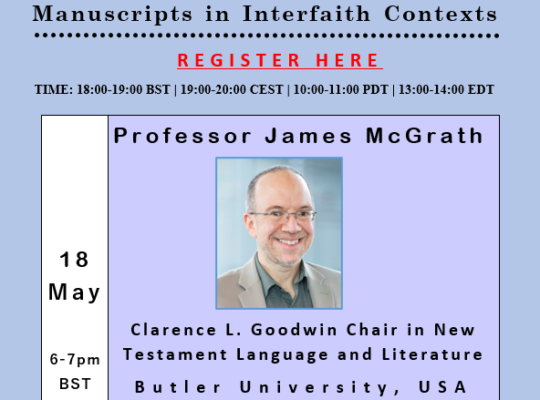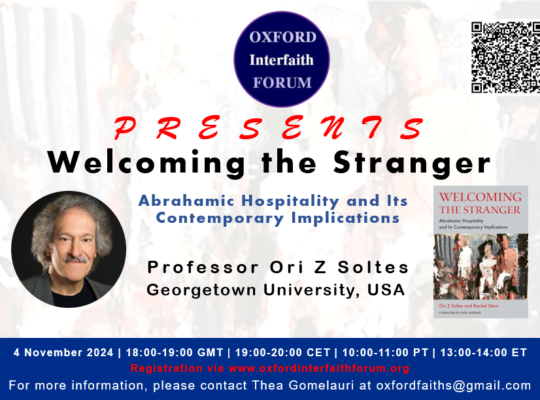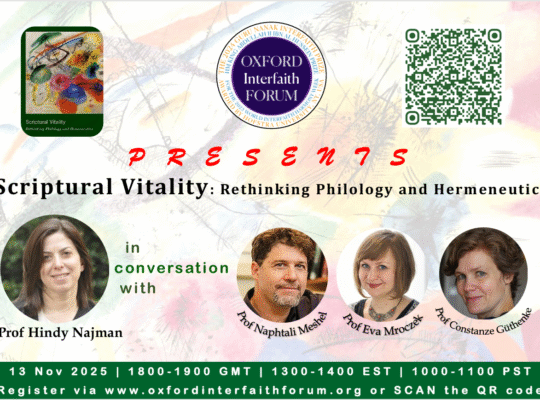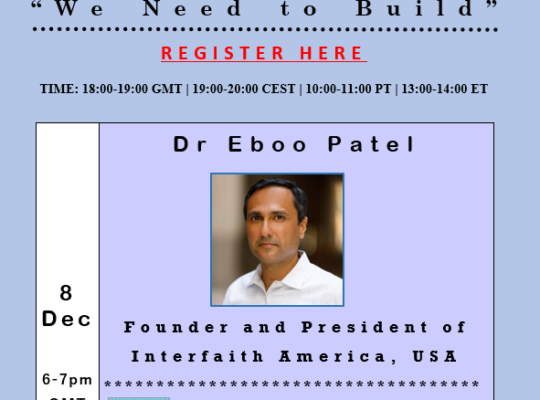28 May, 2024
We are deeply honoured to welcome a Panel of Distinguished Scholars to present the Greatest Medieval Masoretic Pentateuch The Lailashi Codex: The Crown of Georgian Jewry.

Author Dr Thea Gomelauri, together with three renowned scholars of Semitic Languages, Illuminated Jewish Art, and Hebrew Manuscripts, will discuss the fascinating history and content of the Lailashi Codex, and its significance to Biblical scholarship and Jewish Studies.
The Lailashi Codex is the greatest nearly complete Masoretic Pentateuch (see the multicoloured index below). This ancient witness to a scribal tradition known as vavei ha’aamudim (each leaf of the manuscript begins with the letter vav except for the six cases defined by a scribal school) is lavishly adorned with exquisite micrographic designs and calligrams.
Dr Thea Gomelauri’s book The Lailashi Codex: The Crown of Georgian Jewry (Oxford: Taylor Institution Library, 2023) announced, and published for the first time a heretofore unstudied medieval Hebrew manuscript, and its history for the English-speaking world. The provenance of the Lailashi Codex and its trajectory are as mysterious as its authorship and ownership. According to legend, it was brought to Lailashi (Georgia), a remote village at the foothills of the Caucasian mountains, on an angel’s wings. The villagers saw a floating book in a river and rescued it from the stream. This unique artefact was said to have miracle-working powers. It became the best-kept secret of Georgian Jewry.
Map marks significant locations related to the history of the Lailashi Codex, ©Thea Gomelauri
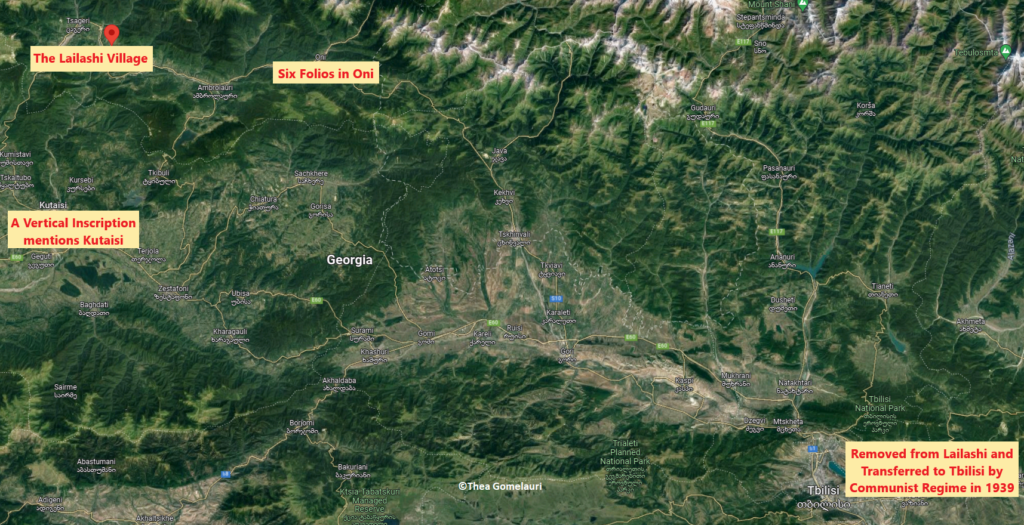
Micrographic designs in the Lailashi Codex, Collage ©Thea Gomelauri

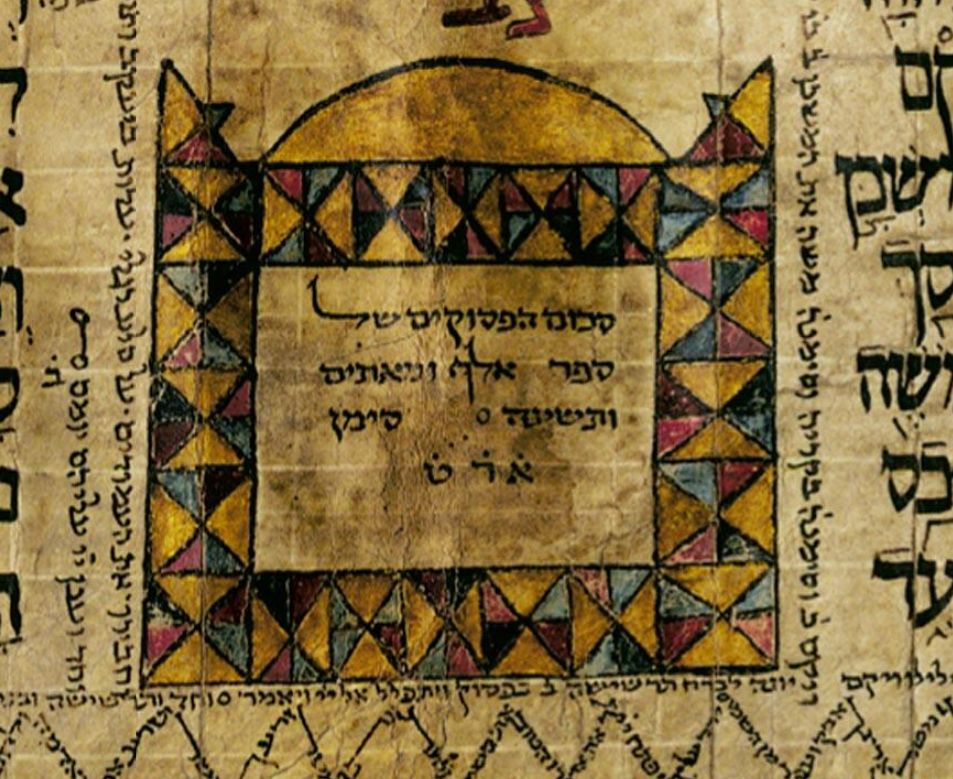

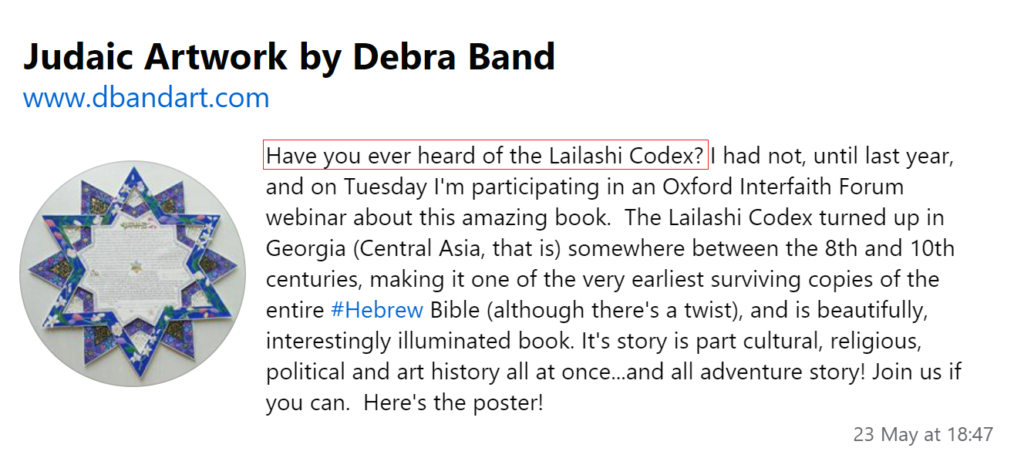

Panel Members:
Dr Thea Gomelauri, Author of The Lailashi Codex: The Crown of Georgian Jewry, is an Associate Faculty Member of Asian and Middle Eastern Studies at the University of Oxford, and Inaugural Director of the Oxford Interfaith Forum.
Professor Geoffrey Khan FBA is a Regius Professor of Hebrew at the Faculty of Asian and Middle Eastern Studies, University of Cambridge, UK. His research publications focus on three main fields: Biblical Hebrew language (especially medieval traditions), Neo-Aramaic dialectology, and medieval Arabic documents. He is the general editor of the Encyclopedia of Hebrew Language and Linguistics and is the senior editor of the Journal of Semitic Studies. His most recent books are Language Contact in Sanandaj: A Study of the Impact of Iranian on Neo-Aramaic (De Gruyter Mouton, 2024); Arabic Documents from Medieval Nubia (University of Cambridge and Open Book Publishers, 2024); and the two-volume The Tiberian Pronunciation Tradition of Biblical Hebrew (University of Cambridge and Open Book Publishers, 2020).
Professor Ori Z. Soltes is a Professor of Jewish Civilization at Georgetown University, USA. He teaches across a range of disciplines, from art history and theology to philosophy and political history. He is the former Director of the B’nai B’rith Klutznick National Jewish Museum, and has curated more than 90 exhibitions across the country and overseas. He has authored or edited 25 books and several hundred articles and essays. Recent volumes include: Welcoming the Stranger: Abrahamic Hospitality and Its Contemporary Implications, with Rachel Stern, (Fordham University Press, 2024); The Problem of God and How Humans Have Tried to Solve it Across History (Generis, 2023); Between Thought & Action: An Intellectual Biography of Fethullah Gülen (Blue Dome, 2022); Tradition and Transformation: Three Millennia of Jewish Art & Architecture (Canal Street Studios, 2016, and second edition: Eshel Books, 2022); Growing Up Jewish in India: Synagogues, Ceremonies, and Customs from the Bene Israel to the art of Siona Benjamin (Niyogi Books, 2021); Magic and Religion in the Greco-Roman world: the Beginnings of Judaism and Christianity (Academia-West Press, 2017); Mysticism in Judaism, Christianity and Islam: Searching for Oneness (Rowman & Littlefield Publishers, 2008); Our Sacred Signs: How Jewish, Christian and Muslim Art Draw from the Same Source (Westview Press, 2005). More information about Professor Soltes’ work is available on his website.
Debra Band is a Senior Fellow of the Oxford Interfaith Forum. She is a distinguished visual artist, scholar of Hebrew illuminated manuscripts, calligrapher, and illuminator. Debra draws upon her love of both the manuscript arts and the Jewish textual tradition in her acclaimed illuminated manuscripts. She is the author and illuminator of Qohelet: Searching for a Life Worth Living, with Menachem Fisch (Baylor University Press, 2024); The Song of Songs: the Honeybee in the Garden (JPS, 2004); I Will Wake the Dawn: Illuminated Psalms with Arnold J. Band (JPS, 2007); Arise! Arise! Deborah, Ruth and Hannah, with Arnold J. Band, (Honeybee in the Garden, 2012); and Kabbalat Shabbat: the Grand Unification, with Raymond P. Scheindlin, (Honeybee in the Garden, 2016), among other works. Debra’s paintings are widely exhibited across the United States and Canada. More information about Debra’s work is available at Judaic Artwork.
Moderated by Professor Ben Outhwaite FRAS FSA, Director of the Taylor-Schechter Genizah Research Unit, University of Cambridge, UK.
Date: 28 May, 2024
Time: 18:00-19:00 BST | 19:00-20:00 CEST | 10:00-11:00 PDT | 13:00-14:00 EDT
Venue: Online
Front Cover (Hardcover)
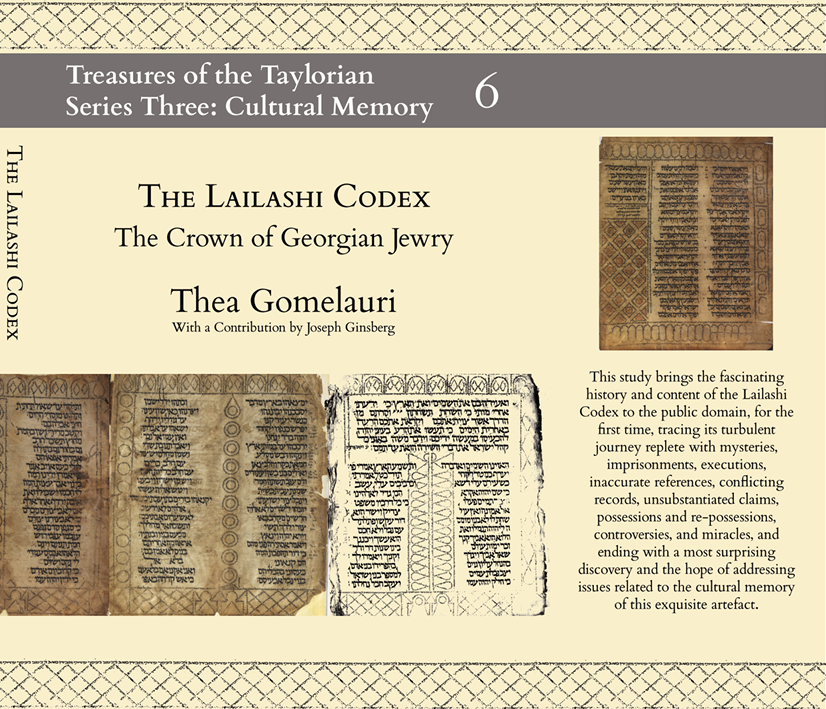
Back Cover (Hardcover)
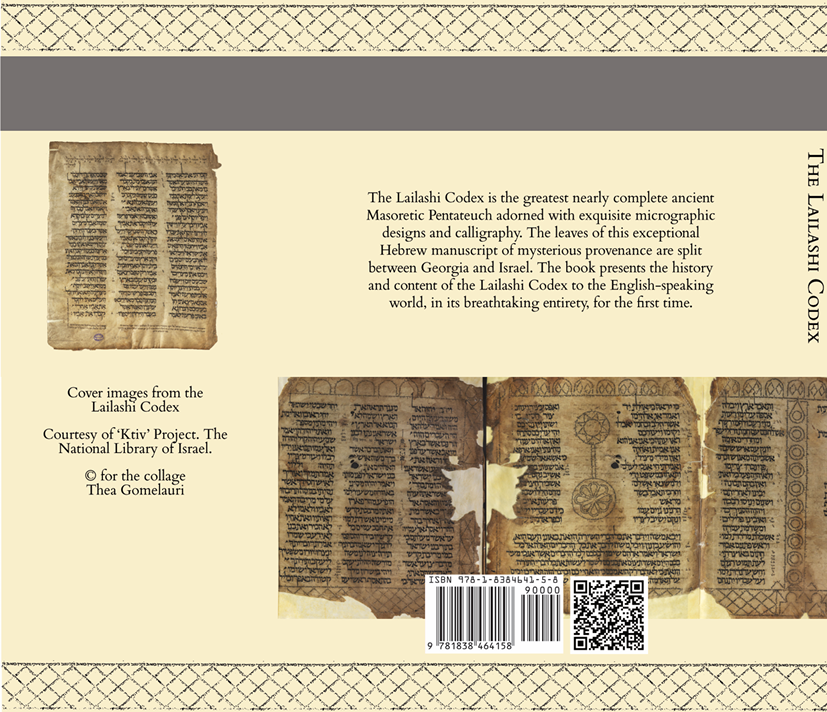
Extracts from the book
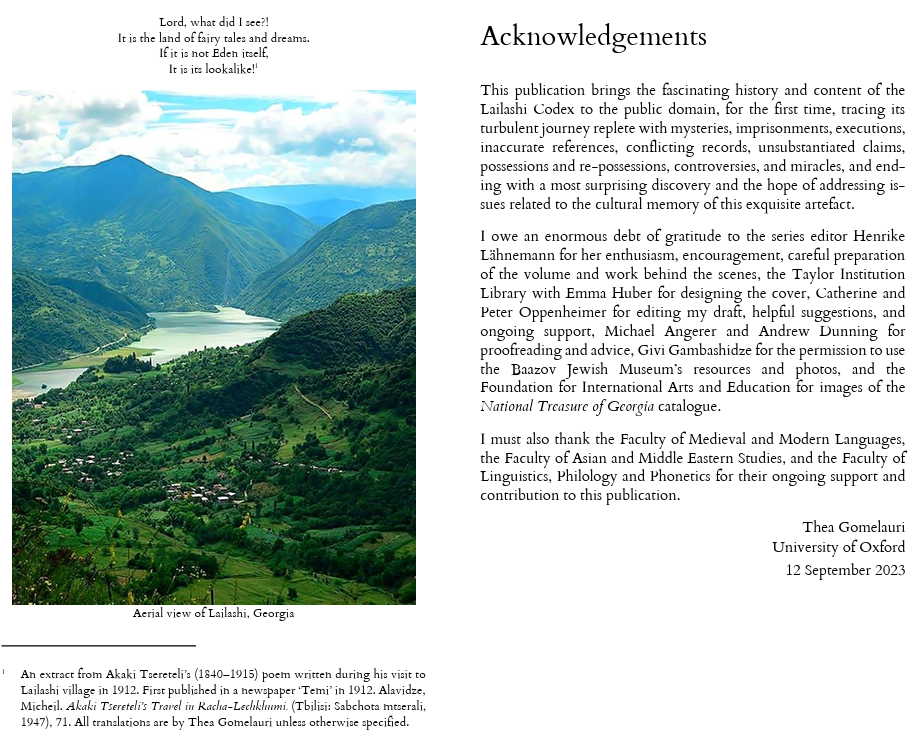
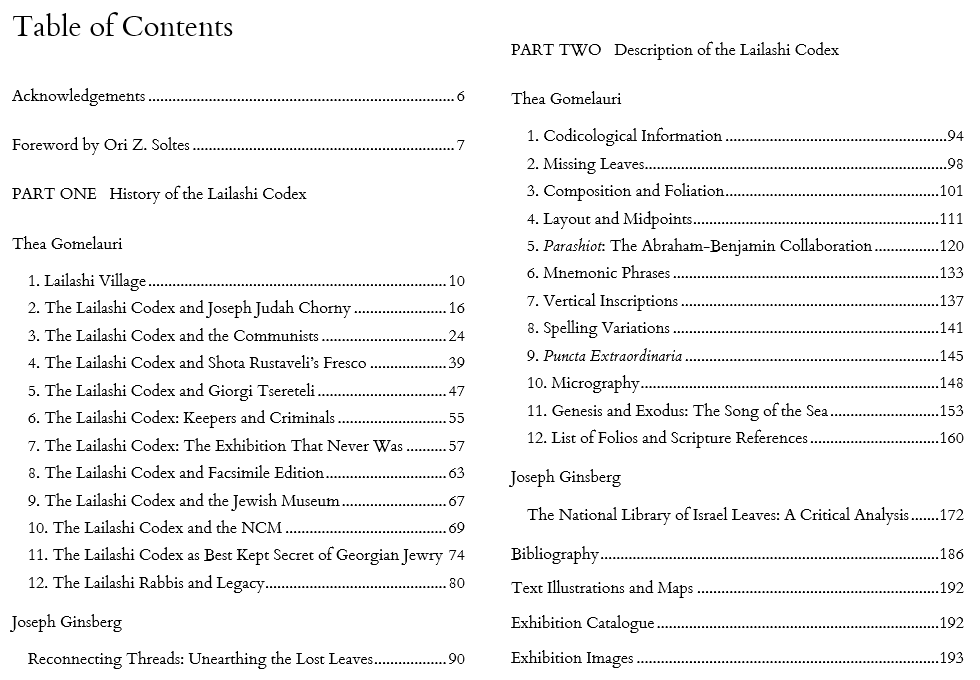
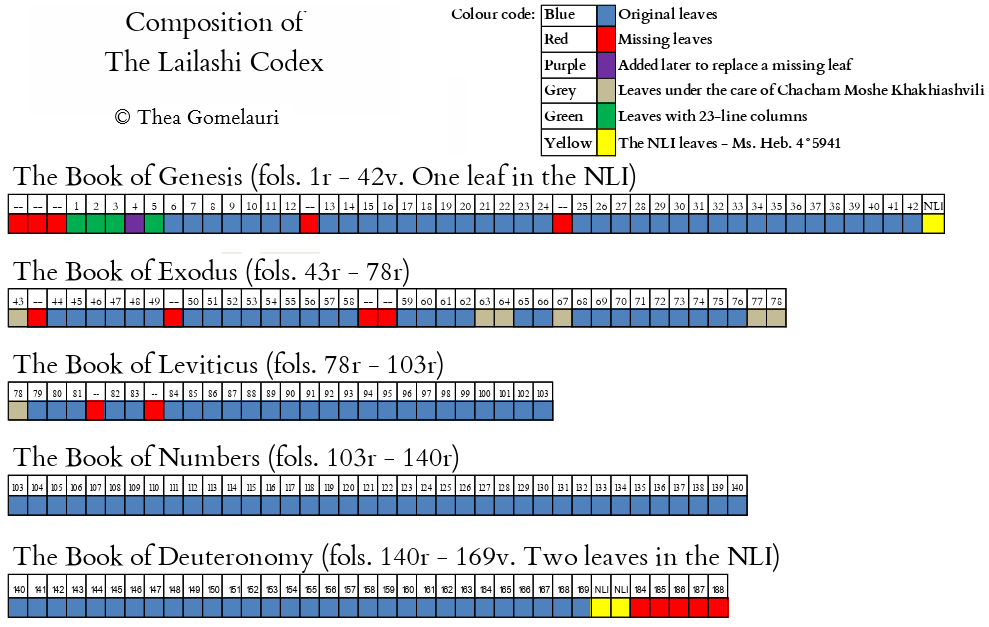
Oops . . . Dear Prime Minister . . . It. Is. Upside. Down❗
Director of the National Centre of Manuscripts in Tbilisi introduces the Lailashi Codex upside-down (!)
to the Prime Minister of Georgia. 15 August, 2014.
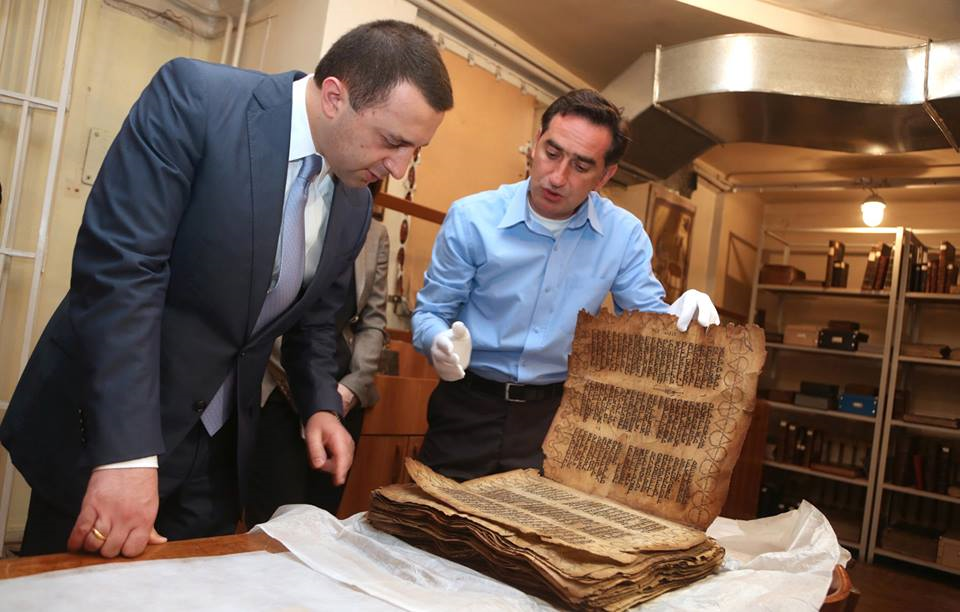
Photo courtesy of https://kvira.ge
The book is available for order in all major bookshops, including Blackwell’s, Waterstones, and Amazon.
PRAISE FOR The Lailashi Codex: The Crown of Georgian Jewry

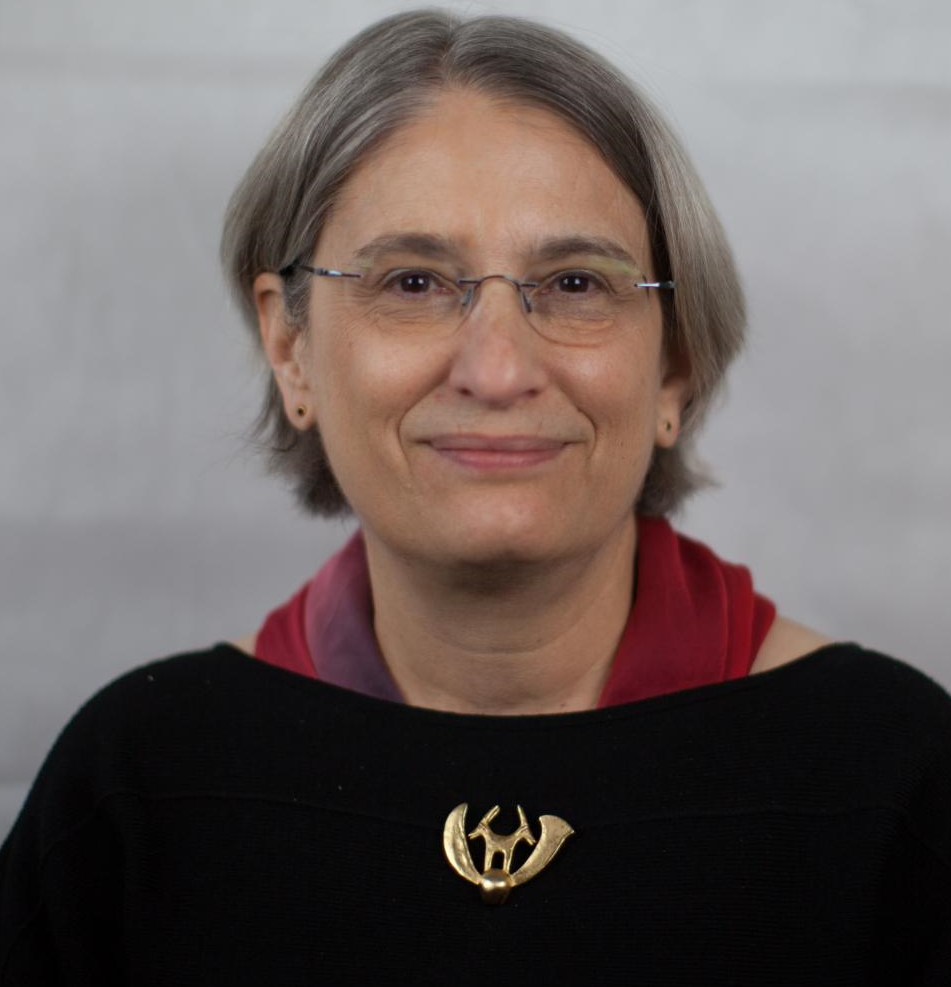
“This book tells the fascinating story of the Lailashi Codex, the priceless medieval Hebrew Masoretic Pentateuch, from its earliest known history as the prized possession of the Jews of Lailashi (Georgia) to its present place in the National Manuscript Centre of Tbilisi, after miraculously surviving the vagaries of Soviet appropriation. Dr Thea Gomelauri’s meticulous description of the manuscript gives a wealth of information on the codicology of the codex and its scribal peculiarities, including the palaeographical signs used to differentiate between the weekly readings of the Torah.”
— Professor Anna Sapir Abulafia FBA, Professor Emerita of the Study of the Abrahamic Religions, Faculty of Theology and Religion, University of Oxford, UK

“Dr Gomelauri restores the ‘biography’ of the Lailashi Codex based on the documentary evidence since its earliest reference to the present day. She presents previously unknown materials about the codex’s vicissitudes during the Soviet period, including its confiscation by the communists in 1939, and the transfer to the Jewish Historic-Ethnographic Museum in Tbilisi. This pioneering study of Dr Gomelauri contributes to several disciplines, including the Transmission of the Hebrew Bible, Jewish Scribal Practices, Textual Criticism, Masoretic Studies, Manuscript Studies, History and Culture of Georgian Jewry, Jewish Illuminated Art, etc. This book opens a venue for further interdisciplinary research. Dr Gomelauri abstains from making ultimate judgments about the provenance of the Lailashi Codex until the conclusion of full-scale research.” (Published in Ancient Jew Review. The full text is available here).
— Professor Golda Akhiezer, Department of Jewish History, Ariel University, Israel

“The calligraphy of the Lailashi Codex is done in a beautiful hand, slowly and carefully, with meticulously formed letters in fine, consistently dark ink. I’m fascinated by the little painting which divides the Book of Exodus from the Book of Leviticus. To my eye, the shape of this little painting looks like an allusion to either a Temple or the classic four-horned altar. I suspect this artist knew the Talmudic descriptions of the decorations, including the inlaid floors, of the Temple, and attempted to reproduce them as he introduced the biblical book focused on Levitical law. The beautiful leaves of the Lailashi Codex show the careful and clear square calligraphy, extensive border micrography, likely of the Masoretic notes and mark the division between the books with a geometric design in micrography and gold, closely related to imagery in the Codex Leningradensis. Let this be the beginning of far greater Western familiarity with this beautiful Crown of the Georgian Jews.” (Extract from a Panel Presentation).
— Debra Band, Visual artist, Calligrapher, Illuminator, and Senior Fellow at the Oxford Interfaith Forum

“One hundred and fifty years after the first news on the manuscript, Dr Thea Gomelauri’s Lailashi Codex presents the first and long-awaited study of one of the most ancient Hebrew Pentateuch, together with the Sassoon and Leningrad Codices. The Lailashi Codex is an invaluable treasure both as a textual witness of the Masoretic Tradition of the Hebrew Bible, and as an artefact for its breathtaking micrography. Nevertheless, it had been completely overlooked by scholars due to the difficulties in reaching the text in Georgia, and because of the lack of any study or edition. Dr Gomelauri’s work fills that void. In addition, and for the first time, the very significant missing leaves of the manuscript, hosted in Israel, are reintegrated into its original milieu. Waiting for a digital or commercial facsimile edition, Dr Thea Gomelauri’s book will become an indispensable tool for the study of the Hebrew Bible.”
— Reverend Professor Ignacio Carbajosa, Professor of Old Testament, San Dámaso Ecclesiastical University, Madrid, Spain

“The Lailashi Codex is a great cultural treasure, and Dr Gomelauri’s book rectifies the history of its neglect. I learned something new on practically every page. A real ‘highlight’ was learning how biblical manuscripts were, in the eyes of the Communists, ‘sources of deceit and fleecing of the working class.’ The story of recovering Shota Rustaveli’s Jerusalem fresco, and the role the Lailashi codex played in it, is terrific. Dr Gomelauri would make a fine investigative journalist.”
— Professor Alan Cooper, Elaine Ravich Professor of Jewish Studies, Chancellor Emeritus of Jewish Theological Seminary, NY, USA

“In her analysis, Dr Gomelauri elucidates the Lailashi Codex‘s multifaceted importance, demonstrating its value beyond its liturgical function as a testament to the historical interconnection of Georgian and Jewish cultural traditions. The book offers a captivating historical narrative, uncovers the latest information about its missing sections, and situates the manuscript within its wider cultural and religious framework. By illuminating the Codex’s tumultuous history, the author ensures that this priceless piece of Georgian-Jewish heritage is acknowledged and valued by future generations. The work will prove to be an invaluable resource for scholars in Jewish Studies, Masoretic Studies, Medieval History, Manuscript Studies, and related fields, offering new avenues for exploration and scholarly inquiry.”(Published in Reviews of
Biblical and Early Christian Studies. The full text is available here).
— Professor Teófilo Correa, Chair of Department for Biblical Studies, Adventist International Institute of Advanced Studies (AIIAS), Philippines
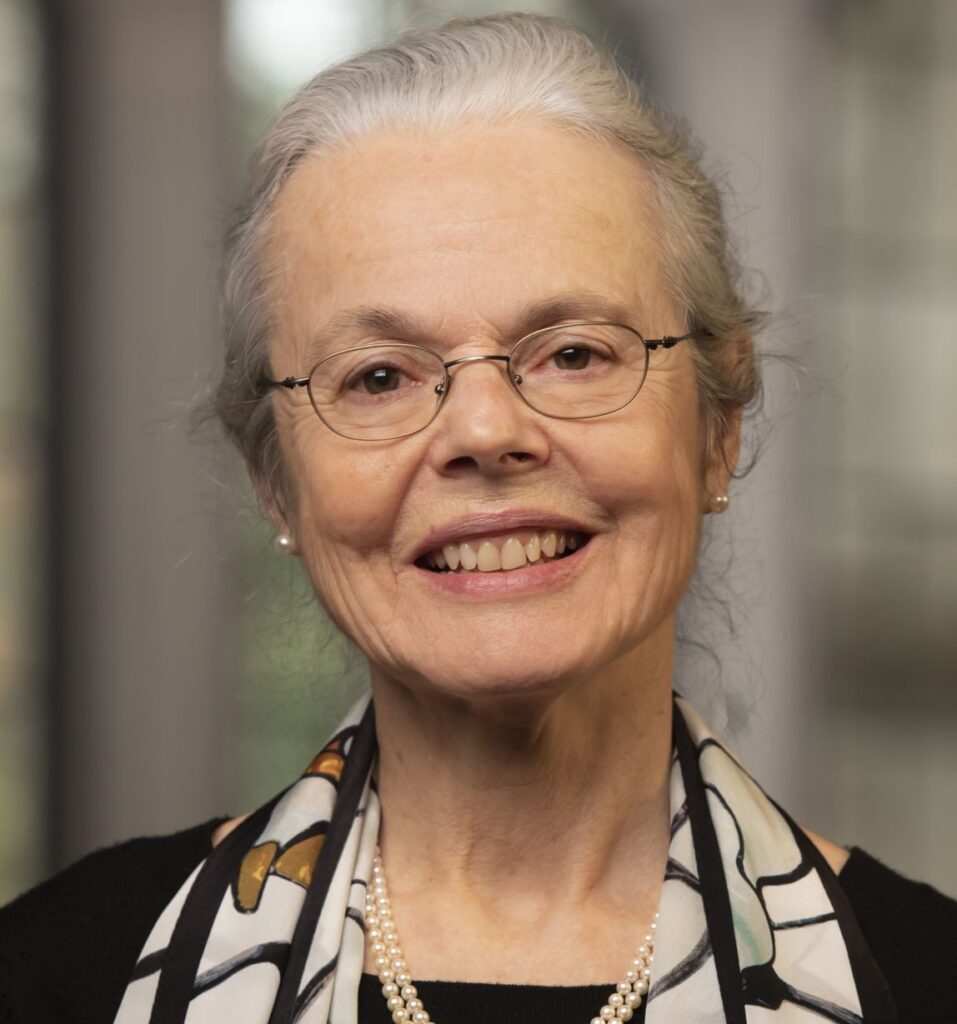
“Dr Thea Gomelauri recounts the still-unfolding drama of an extraordinary manuscript and of those who have cherished it through many generations, as well as of those who have despised or tried to profit from it. Part scribal analysis, part history, compellingly told, this volume is eye-opening for both experts and readers newly introduced to the marvelous exactitude with which biblical manuscripts are produced and the devotion that ensures their preservation.”
— Professor Ellen Davis, Amos Ragan Kearns Distinguished Professor of Bible and Practical Theology, Duke Divinity School, Duke University, USA

“‘This is an eye-opening work. The Masoretic Text, the text curated by the Masoretes for more or less a millennium, is the starting point for any study of the Hebrew Scriptures, and the Dead Sea Scrolls have confirmed that their text is a precious testimony to the care with which they copied the Scriptures over the centuries. The emergence into Western European awareness of such a careful copy of this text that looks as if it might be as old as the tenth or eleventh century and thus be at least as old as our standard versions is therefore an exciting moment. And the tale about it that Dr Thea Gomelauri tells is a fascinating one.”
— Reverend Professor John Goldingay, DD, Senior Professor of Old Testament and David Allan Hurbbard Professor Emeritus of Old Testament, Fuller Theological Seminary. Oxford, UK

“This is a fascinating study and beautiful work on one of the most valuable discoveries in biblical scholarships and Jewish history that brings together Georgian Republic Jewish History with the history of the Lailashi Codex. I’ve learned a lot about the special features of the manuscript and Georgian Jewry.”
— Haim Gottschalk, Judaica Librarian for the Asian and Middle Eastern Division, Library of Congress, USA
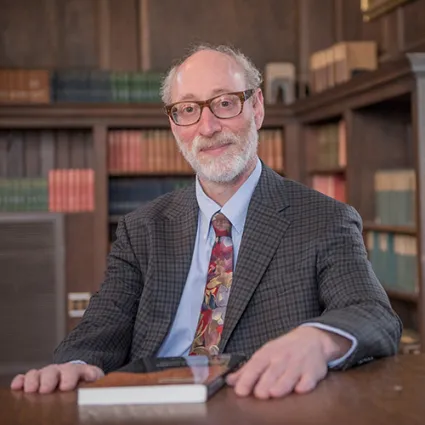
“This book introduces readers to one of the most important and understudied Masoretic Torah manuscripts as well as to the Georgian Jewish community who preserved and treasured this sacred text for centuries and from whom the Soviet communists expropriated it. While scholars who specialize in the textual history of the Bible will benefit greatly from Dr Thea Gomelauri’s detailed analyses of the manuscript and its unusual features, anyone interested in Biblical Studies or in the broader sweep of Jewish history will learn much from the stories and history surrounding the Lailashi Codex and its rediscovery.”
— Professor Joel Kaminsky, Morningstar Professor of Jewish Studies and Professor of Biblical Literature, Smith College, USA
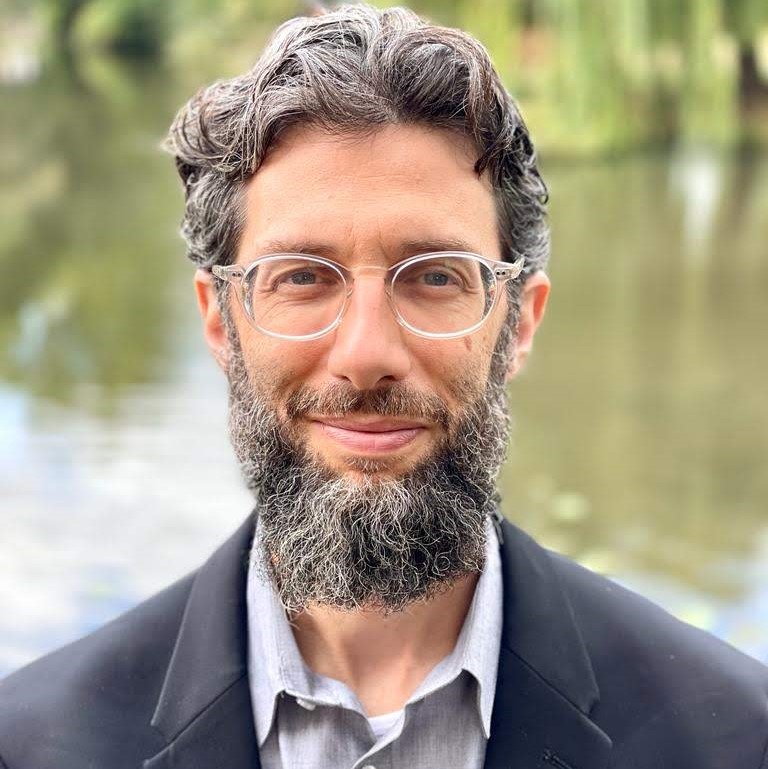
“The two parts of the book are each fascinating in different ways. The cultural history told in Part 1 opens up an entire area of Jewish history – the intellectual history of Lailashi and the surrounding Georgian regions – that is underappreciated and deserves more study. The codex studied by Dr Thea Gomelauri makes it clear that this was no backwater, though: it is a beautiful manuscript written to exacting standards. Part 2 is a meticulous analysis of the text itself, which documents numerous interesting features and adds data to many topics of inquiry into the traditions and history of the manuscript. The book includes three leaves housed in the National Library of Israel and identified recently by Joseph Ginsberg who is given the space to tell the story of the discovery from his own perspective and add a chapter of analytical work, as well. Kudos to Dr Gomelauri on such excellent work!”
— Professor Aaron Koller, Professor of Near Eastern Studies, Yeshiva University, NY, USA
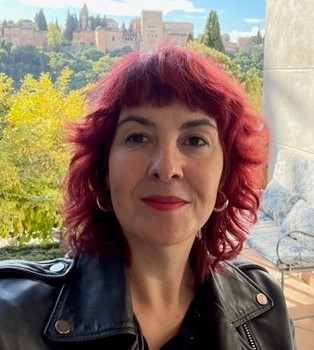
“Thea Gomelauri’s study rescues the Lailashi Codex from oblivion. The book is clear and informative. The various tables and figures are very useful for visualising some of the aspects of the manuscript discussed in greater depth (listed on p. 191). The attention to detail in the Masorah and comparative studies is especially valuable. Dr Gomelauri’s study significantly advances our understanding of this manuscript. This book not only recovers the memory of an important manuscript but also lays the groundwork for more in-depth and specialised research on this unique manuscript.” (Published in SEFARAD, Vol. 84, No. 1, 2024. The full text is available here.)
— Dr Elvira Martín Contreras, Scientific Researcher, and the former Head of the Jewish and Islamic Studies at the Institute of Languages and Cultures of the Mediterranean and the Near East (ILC), Spanish National Research Council (CSIC), Madrid, Spain

“Dr Gomelauri’s work on the Lailashi Codex charts a journey through ten centuries of history in a way that is romantic and engaging to a modern reader. The fidelity and accuracy with which the scribes transmitted the sacred texts across countries and across centuries are astonishing. In pursuit of her subject, Dr Gomelauri is no less meticulous than the scribes she studies, and she makes the distant past accessible, through story-telling and human sympathy, to the ordinary reader in the present day. Her work deepens and extends our understanding of the work of the mediaeval inheritors of the biblical texts.”
— Peter Oppenheimer, Emeritus Governor and former President of the Oxford Centre for Hebrew and Jewish Studies, Emeritus Fellow of Christ Church College, University of Oxford, UK

“We knew nothing about this manuscript beyond its name – for the sole reason that this singular treasure has been housed in Georgia apparently for one millennium. All that changes now with this engaging and informative description of the Lailashi Codex from the pen of Thea Gomelauri: engaging as she tells the story of the manuscript, informative as she details its scribal features. May this book convert the Lailashi Codex from the “best-kept secret [in] biblical scholarship” (in the words of the author) to an object of study for generations to come.”
— Professor Gary A. Rendsburg, Blanche and Irving Laurie Chair in Jewish History, Distinguished Professor of Jewish Studies, Rutgers University, USA

“This is a fascinating, the first full-length introduction to a little-known but exceptional early medieval Hebrew manuscript of the Torah, preserved by Georgian Jews. Dr Thea Gomelauri recounts its trials and tribulations, and provides a detailed description of the nature of its scribal features within the Masoretic tradition contributing to the knowledge of the history, and development of Jewish scribal practices.”
— Professor Alison Salvesen, Professor of Early Judaism and Christianity, and Supernumerary Fellow of Mansfield College, University of Oxford

“This volume tells us two amazing stories. First is the account of the miraculous survival of this ancient manuscript of the Torah in the Georgian Jewish community, and then through the vicissitudes of communist rule. Then we read the detailed account of the nature of the text, its Masoretic annotations, and the codicological features of this amazingly beautiful Codex. Dr Thea Gomelauri is to be congratulated for writing the great book and including contribution by Joseph Ginsberg. This study certainly increases our knowledge of the history of the Masoretic text of the Hebrew Bible.”
— Professor Lawrence H. Schiffman, Global Distinguished Professor of Hebrew and Judaic Studies, Skirball Department of Hebrew and Judaic Studies, New York University, USA

“I could hardly be more thrilled to see such an extraordinary volume dedicated to this most extraordinary object among the spectacular artefacts that have been produced in Georgia over the millennia. The Lailashi Codex, together with other facets of Georgian Jewish history and material culture, offers great insights into the unique position of Jews in this country situated between the Christian and Muslim worlds. The organisation of the volume by Dr Thea Gomelauri is admirable and more than praiseworthy. This magnificent presentation is a special treat for the worlds of scholars and devotees who can admire and re-explore it for many generations to come.”
— Professor Ori Z. Soltes, Professor of the Teaching of Jewish Civilization, Center for Jewish Civilization, Georgetown University, USA

“The Lailashi Codex is a truly remarkable Hebrew Bible manuscript, not only for its intrinsic value as a Bible but also for its life story and career as a book. The total story is fascinating and riveting.”
— Professor David Stern, Harry Starr Professor of Classical and Modern Hebrew and Jewish Literature, Professor of Comparative Literature at the Near Eastern Languages and Civilizations Department, Harvard University, USA

“This book introduces the fascinating but little-known world of the ancient Eastern Pentateuch owned by the small Jewish Community in Lailashi village (Western Georgia), which was inaccessible to biblical world until now. Dr Thea Gomelauri’s study reveals the exquisite features of the Lailashi Codex which exhibits affinity to the most important codices of the tenth–eleventh centuries. This lavishly illustrated ancient witness to the Jewish scribal traditions known as vavei ha’aamudim, and b’yah sh’mo will inspire further research, and enrich our knowledge about early biblical codices, and their extraordinary scribes.”
— Michal Sternthal, Head of the Hebrew Illuminated Manuscripts Section, Center for Jewish Art, The Hebrew University of Jerusalem, Israel
Recording of the Book Presentation at the Oxford Interfaith Forum, 28 May, 2024
Online Presentation at the Conference on At the Crossroads of Cultures: The Jews of Central Asia and the Caucasus, organised by the Jewish Museum and Tolerance Center (Moscow) with the Ben-Zvi Institute (Jerusalem) and the Georgian American University (Tbilisi), 5-8 June, 2024
Recording of the Book at Lunchtime at the Oxford Research Centre in the Humanities (TORCH), 22 January, 2025
BOOK PRESENTATIONS
Book Presentation at the Nizami Ganjavi Centre at the University of Oxford & New College
29 February, 2024
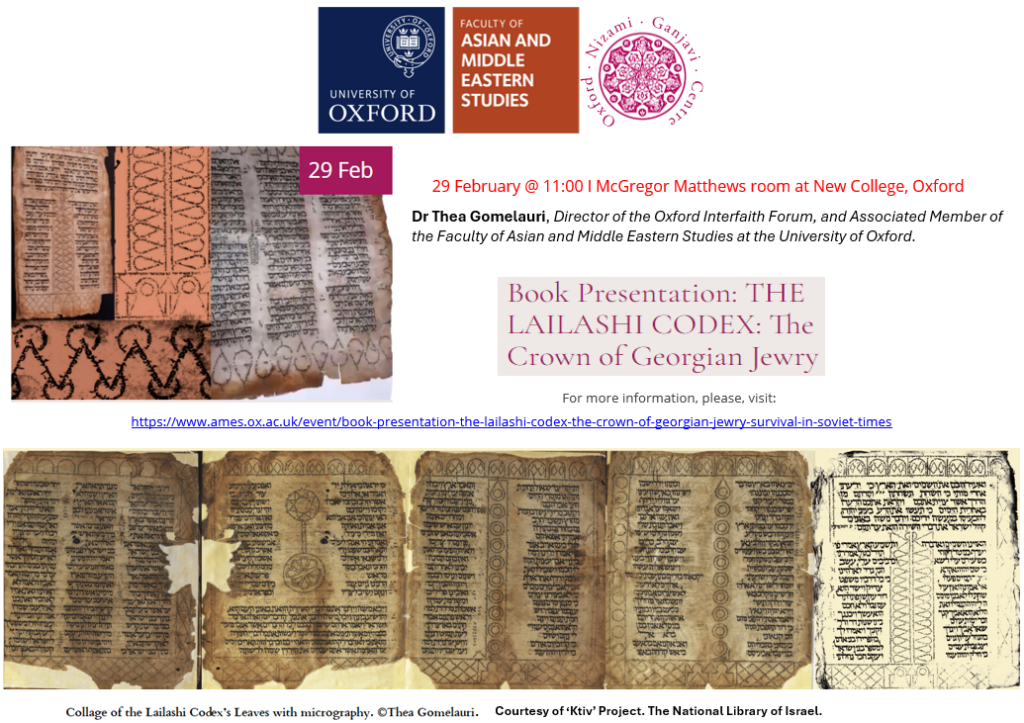
Presentation at Weston Library (Bodleian Library) at the University of Oxford, 3 May, 2024
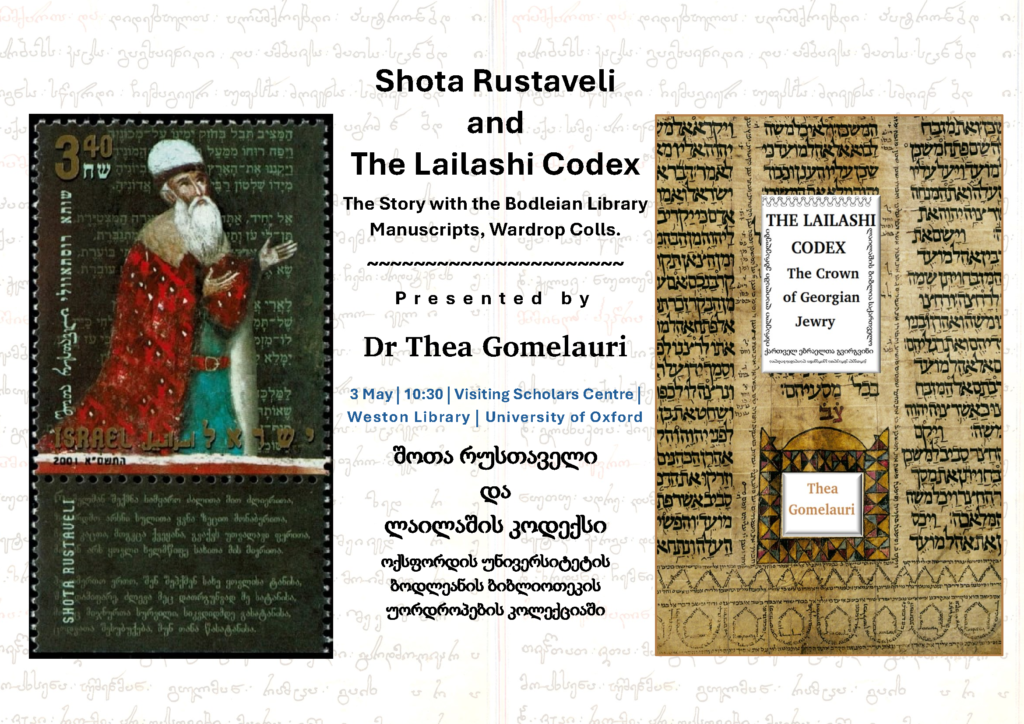
Book Presentation Hosted by New Books Network, 1 June, 2024

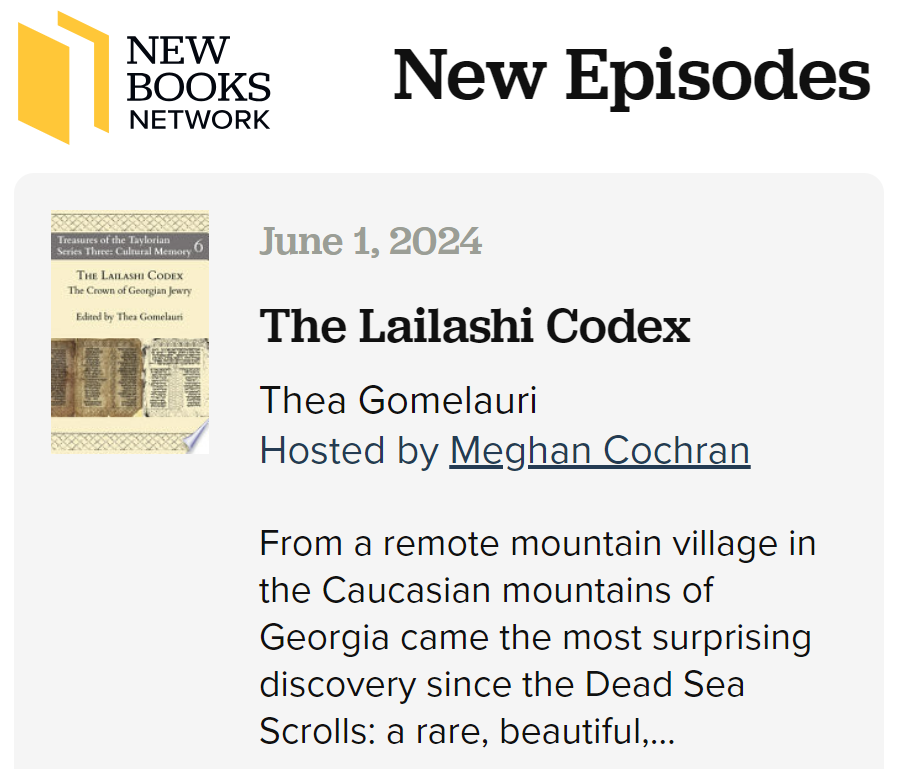
“From a remote mountain village in the Caucasian mountains of Georgia came the most surprising discovery since the Dead Sea Scrolls: a rare, beautiful, and valuable Hebrew Bible known as the Lailashi Codex. – – In ancient tradition, scribal art possesses supernatural powers. The provenance of this Codex is shrouded in mystery. Questions about the authorship and ownership surround this ancient work of treasure and secrets. The Codex, written as a labour of love by a scribe of rare skill, was hidden from public view until now.
The Lailashi Codex: The Crown of Georgian Jewry (Oxford: Taylor Institution Library, 2023) explores the history and content of this extraordinary work, the earliest surviving nearly complete medieval Hebrew manuscript of the Pentateuch with Masoretic vocalization adorned with intricate micrography.
This book examines the story of the Codex through international controversies, repossessions, and local rivalry, particularly under Communist rule and the volatile politics of the post-Soviet era.
For the first time, readers can see the well-preserved leaves adorned with micrographic designs and read details regarding the composition and layout of the manuscript, vertical inscriptions, enigmatic mnemonic devices, missing folios, spelling variations, and micrographic shapes. It includes a full index of the biblical text and introduces the content of the genius scribe. The volume contains rich archival photos and Jewish historical documents published for the first time.”
— Meghan Cochran at the New Books Network.

Book Presentation at the Oxford Research Centre in the Humanities (TORCH), 22 January, 2025
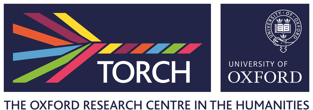
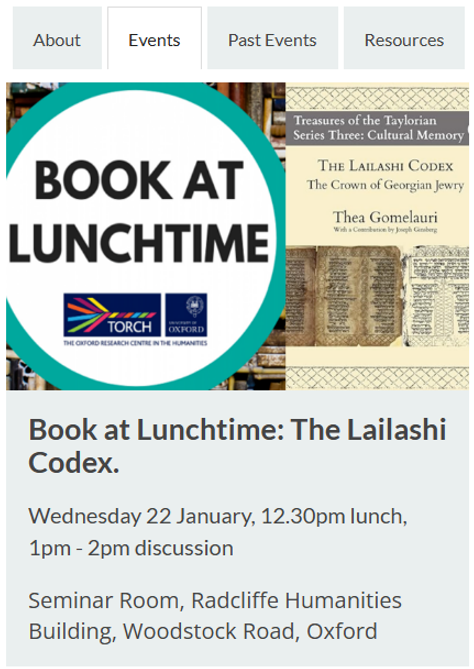
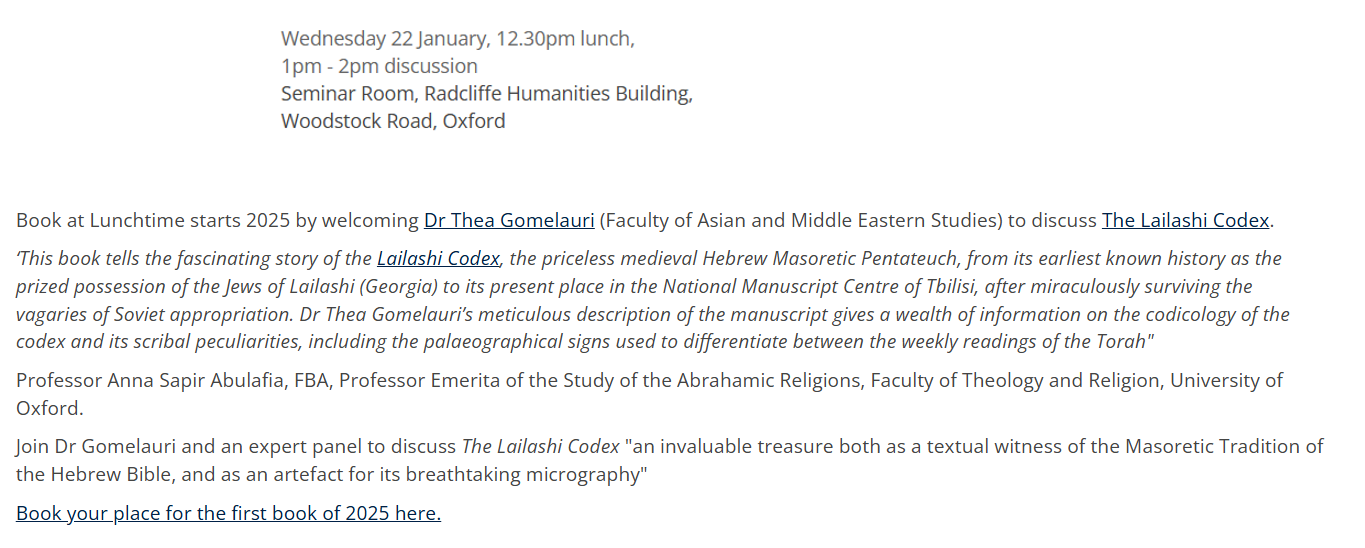

MEDIA COVERAGE
The Mosaic Magazine (NY, USA), 21 April, 2021
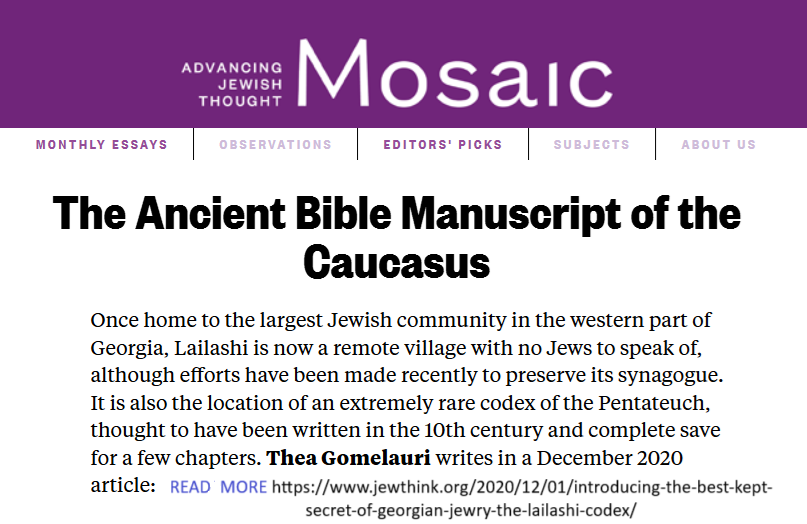
The Mosaic Magazine (NY, USA), 26 June, 2024
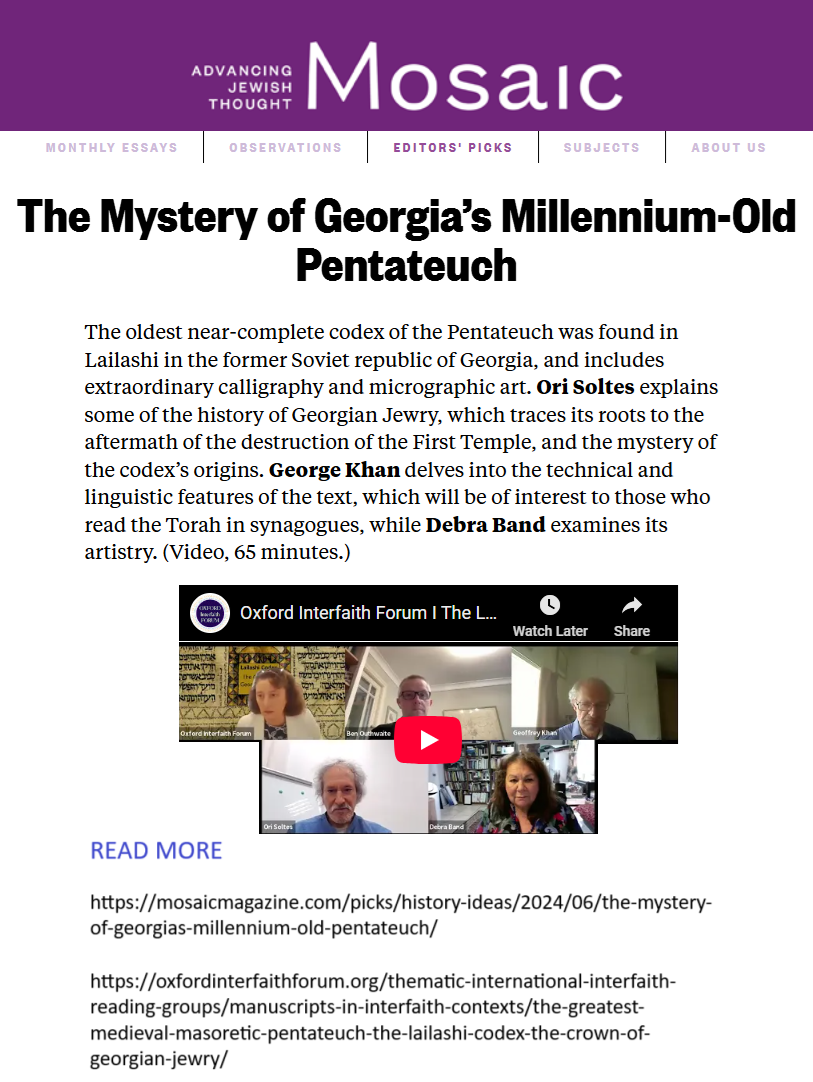
Magazine Menora, No. 3 (509).
March (Adar II). 2024 (5784).
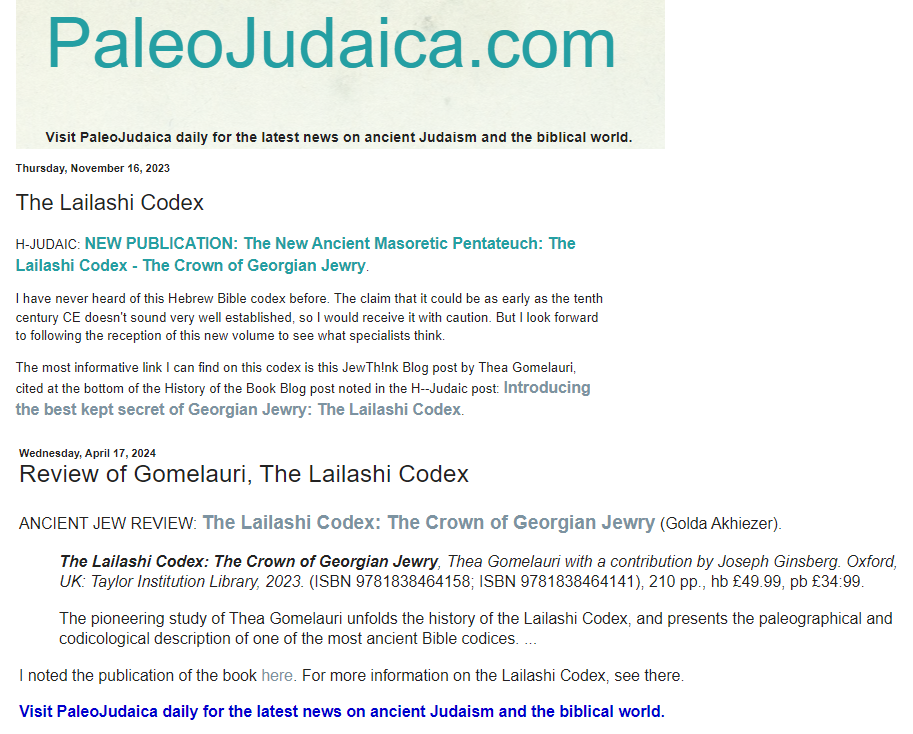

BOOK REVIEWS
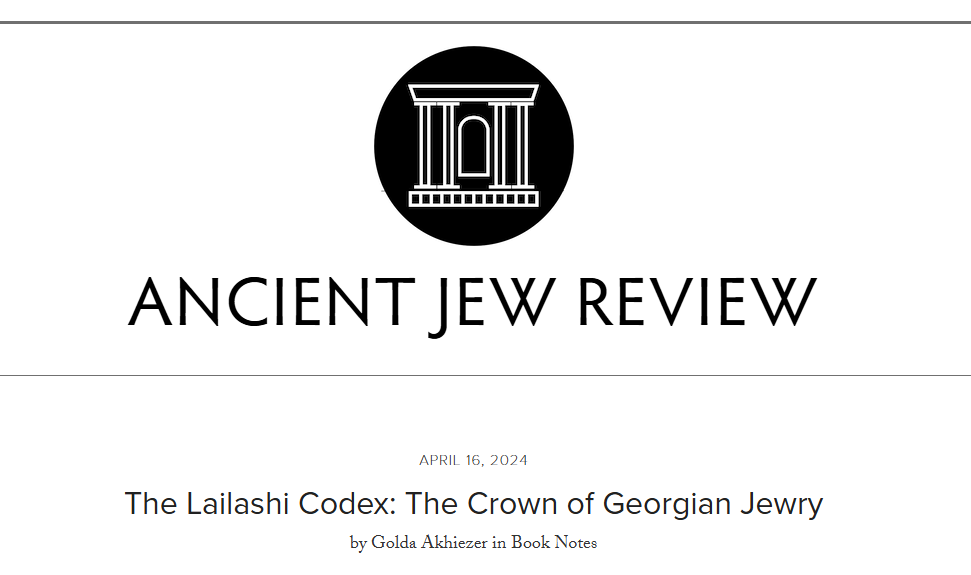
BOOK REVIEW by Professor Golda Akhiezer, Department of Jewish History, Ariel University, Israel.


January 2, 2025
BOOK REVIEW by Professor Teófilo Correa, Adventist International Institute of Advance Studies (AIIAS).


Professor Elvira Martín-Contreras’ Review (in Spanish Language), published in SEFARAD Vol. 84, No. 1 (2024)
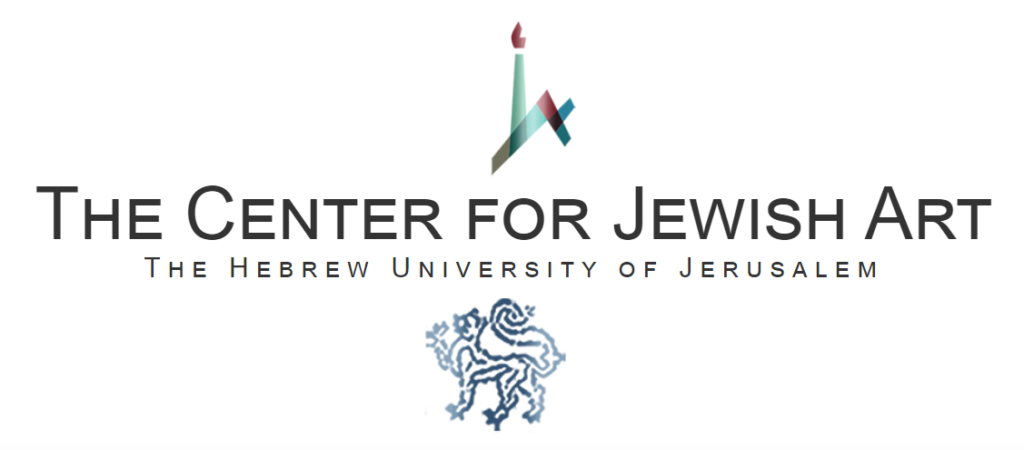

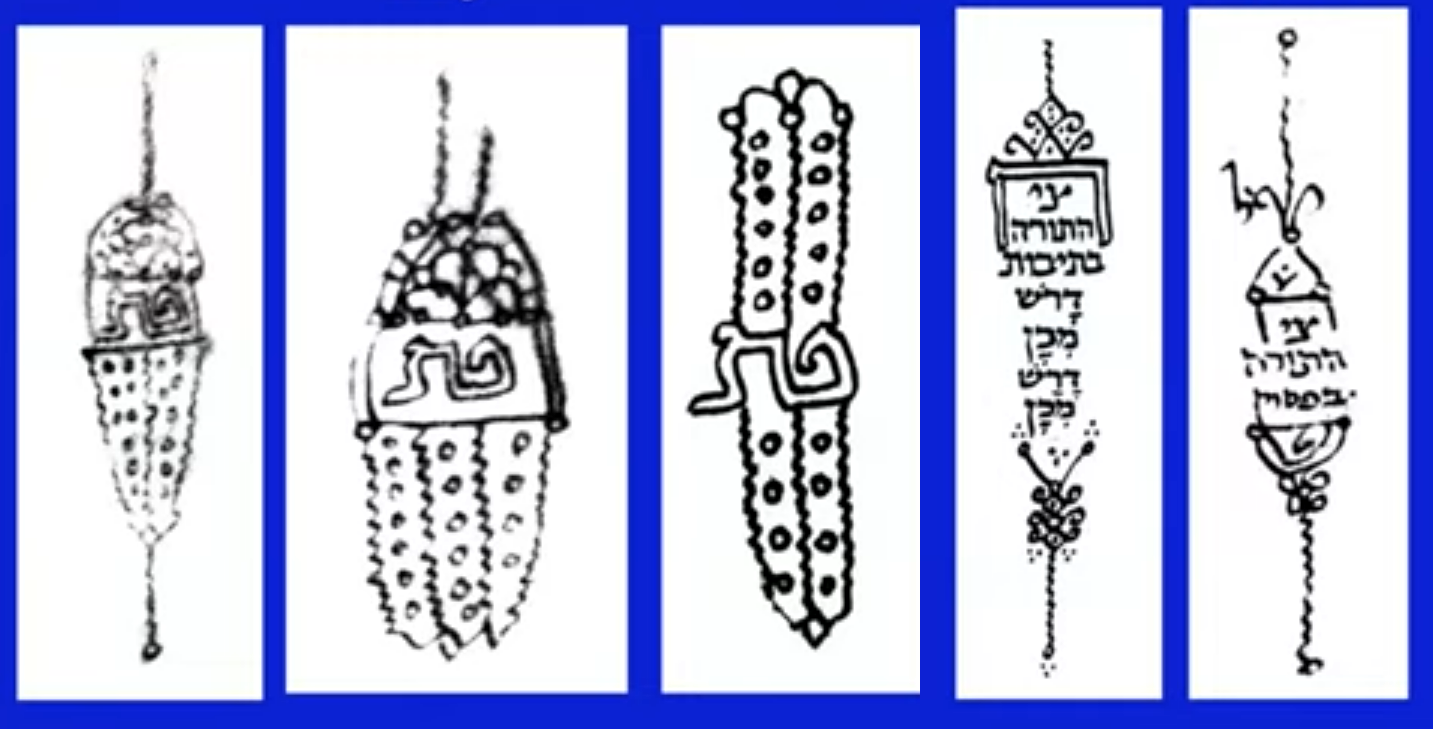


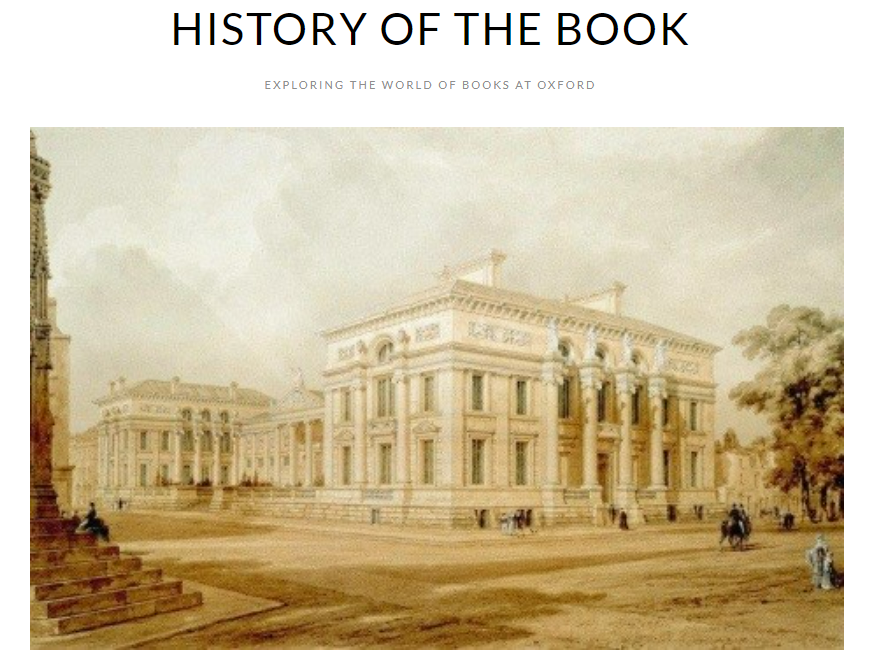
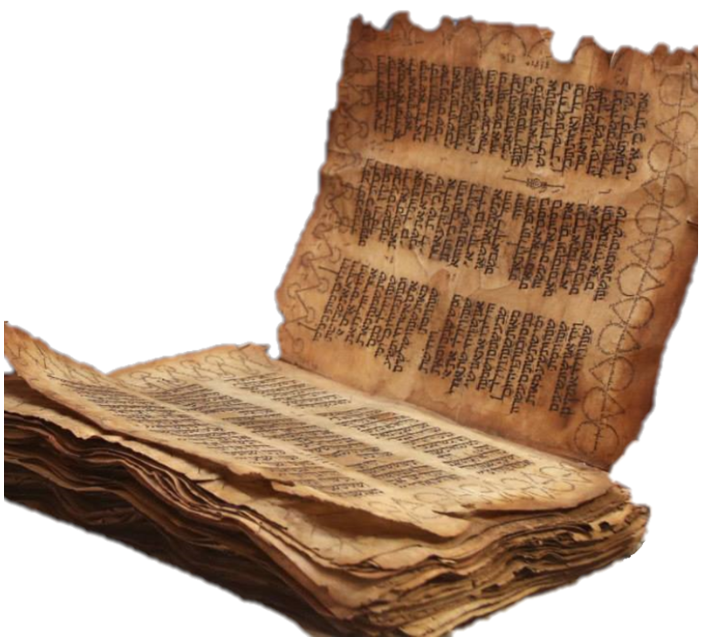
The Book is available:

Library of Congress Catalogue record: https://lccn.loc.gov/2023518057
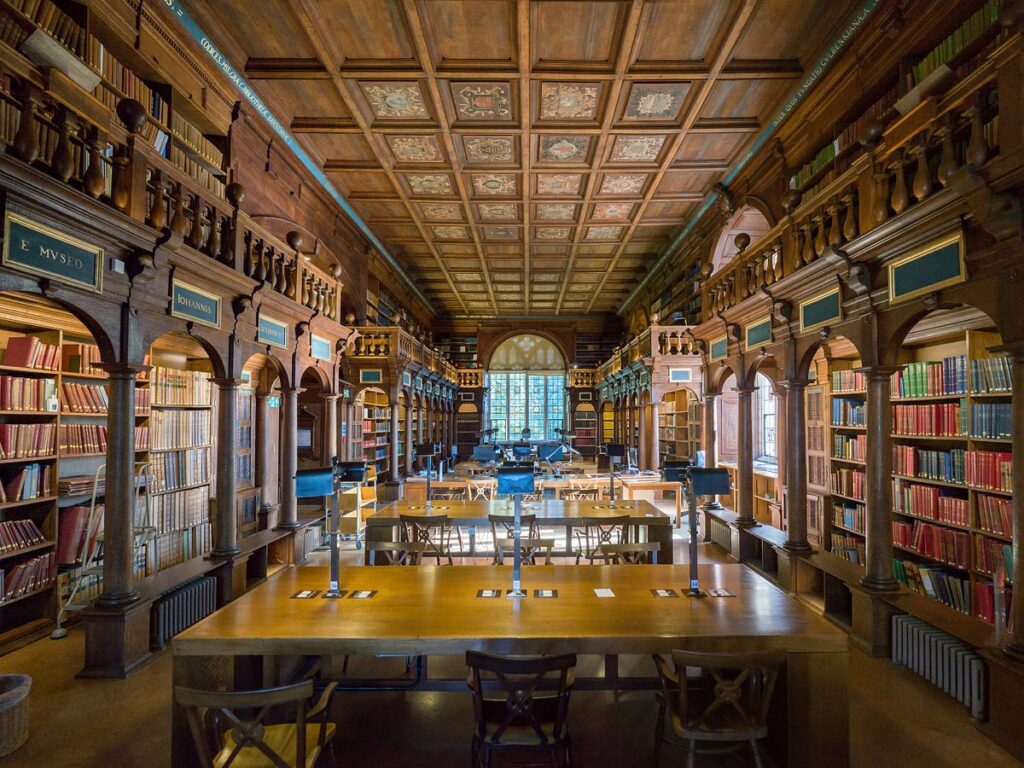
The University of Oxford Bodleian Library catalogue record: https://tinyurl.com/mrxd88c2

The Library of the Ben Zvi Institute (Yad Ben Zvi), Jerusalem, Israel: Record number
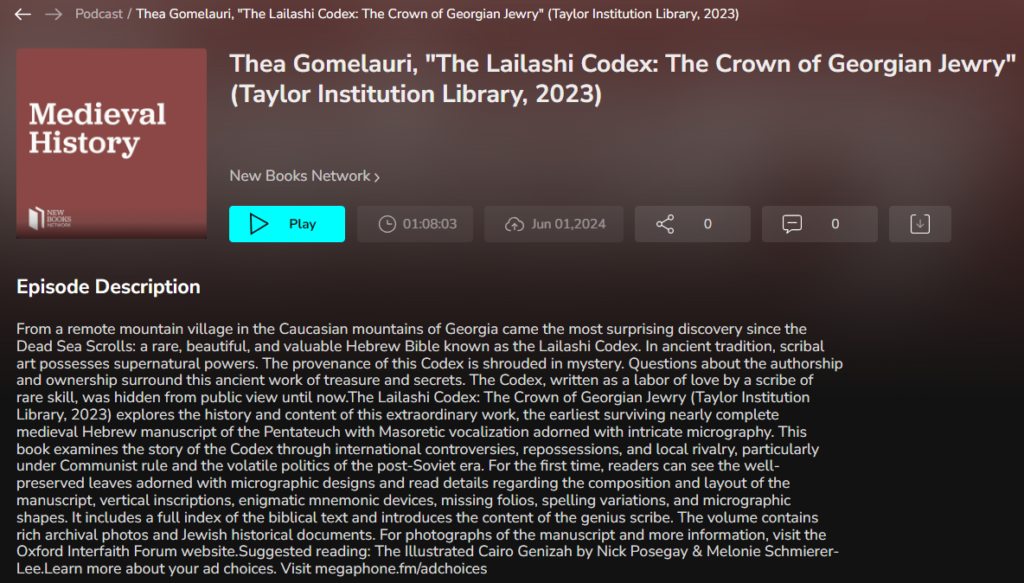
Related Sessions:
- The Greatest Medieval Masoretic Pentateuch: The Lailashi Codex—The Crown of Georgian Jewry
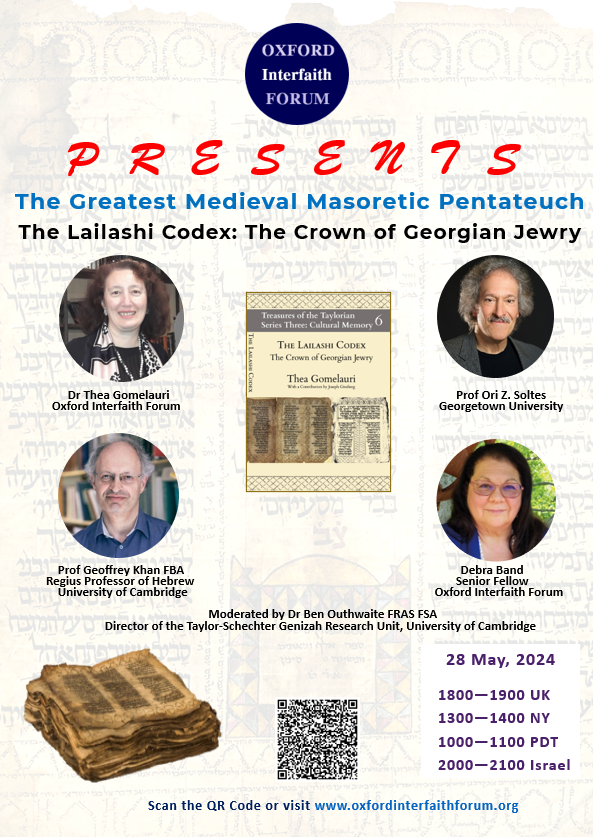
- A Curious Megillat Esther or How to Find a Needle in a Haystack
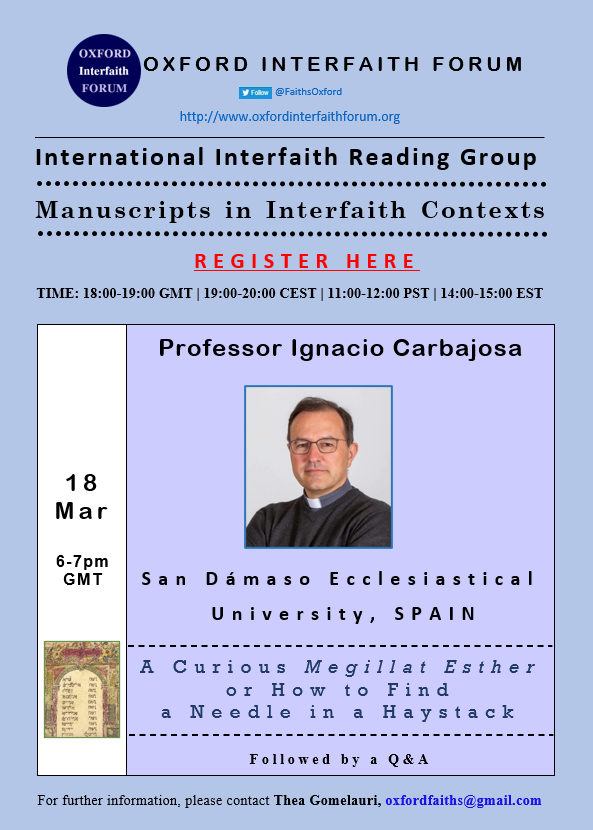
- The Dead Sea Scrolls and Jewish-Christian Dialogue
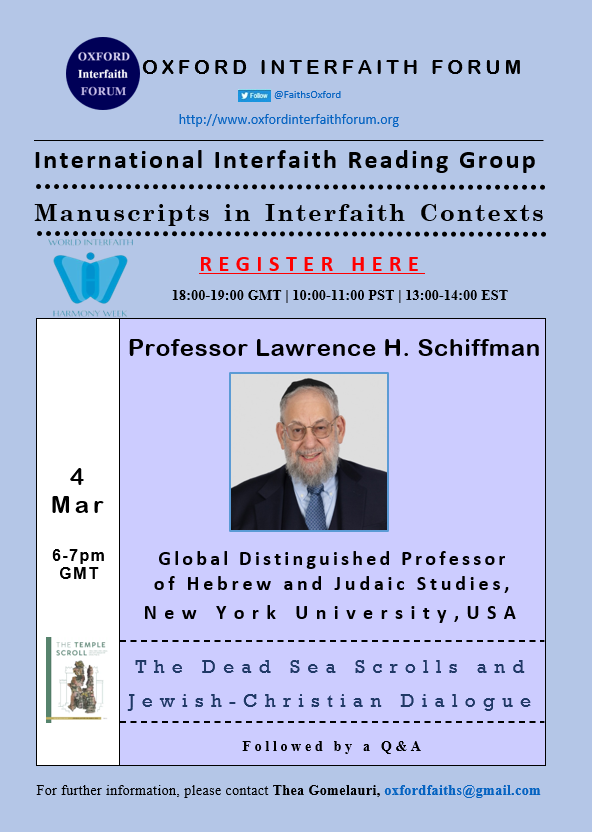
- Christian Images and Jewish Desecrators: The History of the Allegation in Manuscript Illustrations
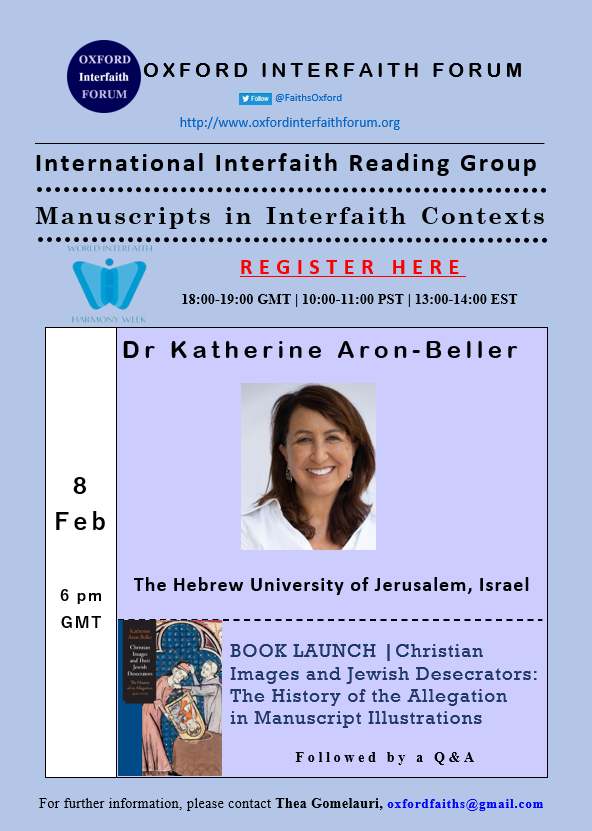
- A Book for All Seasons: Medieval Liturgical Psalter

- A Medieval Franciscan Consults the Jews: Nicholas of Lyra on how to Imagine the Temple
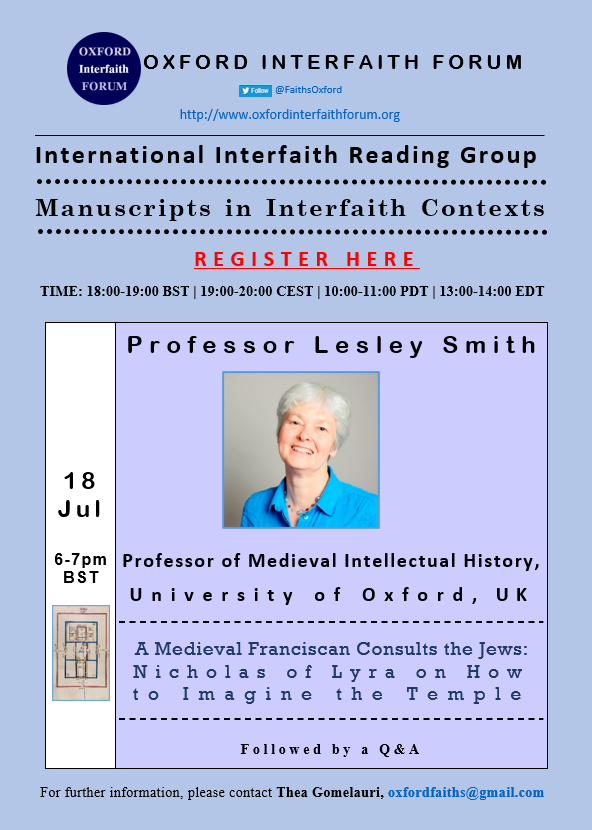
- The Dead Sea Scrolls at 75: The Texts, Their Contexts, and the Coalescence of Jewish and Christian Scholarship
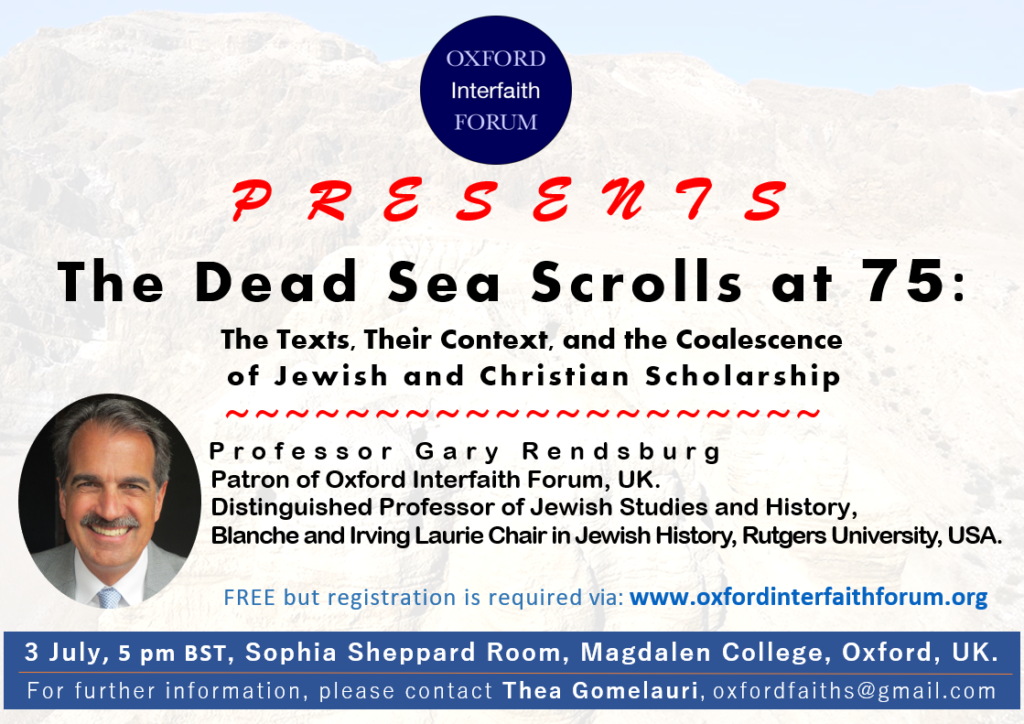
- British Library Hebrew Treasures Reveal Interfaith Narratives: The Sana’a Pentateuch

- Mandaeans: A Minority on the Move and their Manuscripts
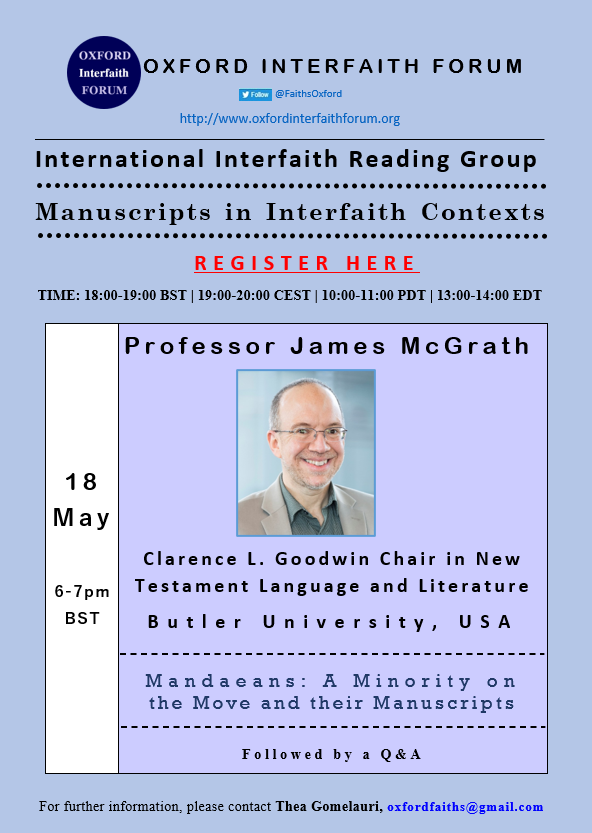
- The Popes and the Jews in Sixteenth-Century Italy through the Chronicle of Pope Paul IV
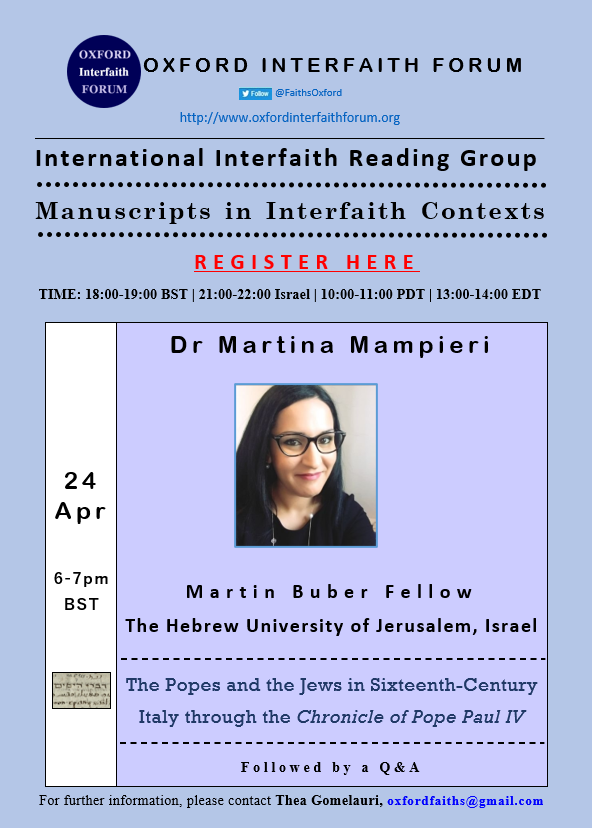
- The Passover Haggadah through the Ages: Jewish Text, Christian Surprises
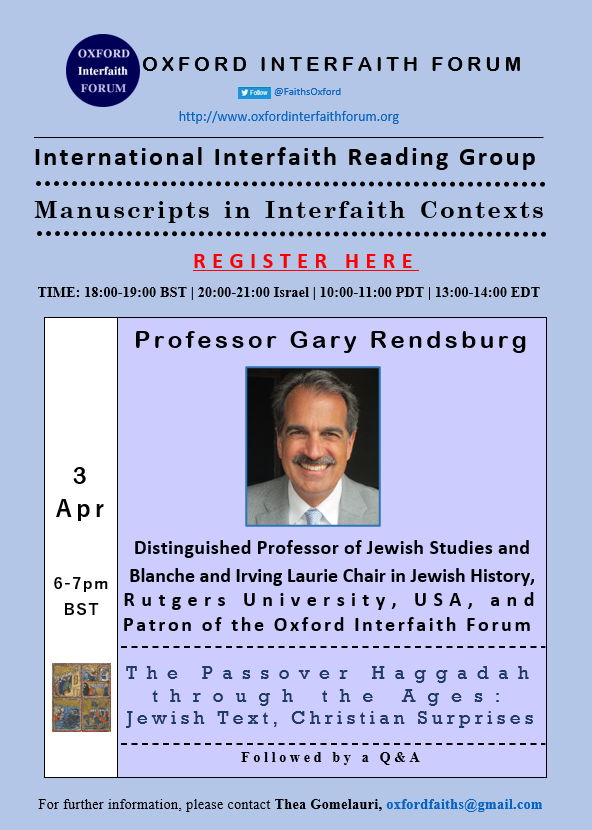
- Material and Linguistic History of Arabic Manuscripts in Muslim and Jewish Contexts
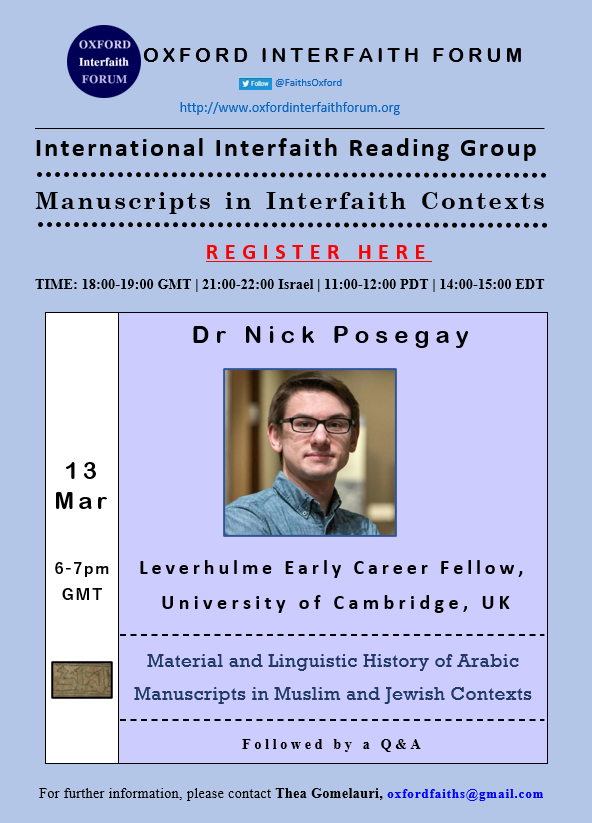
- Serendipitous Manuscripts: Karma Pakshi’s Memoirs, Past Lives, and Poetry
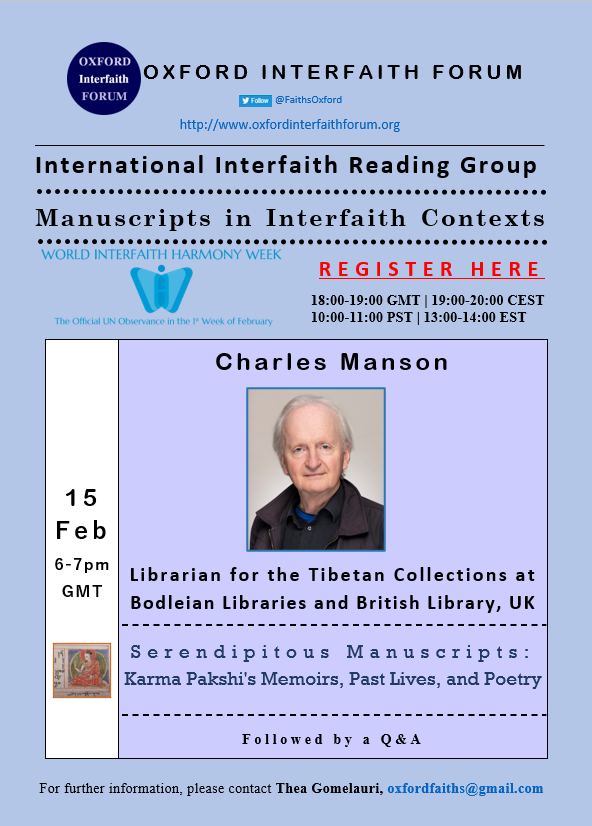
- The Kennicott Bible: The Greatest Bible Ever Written
